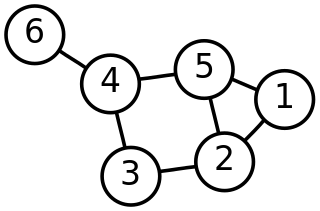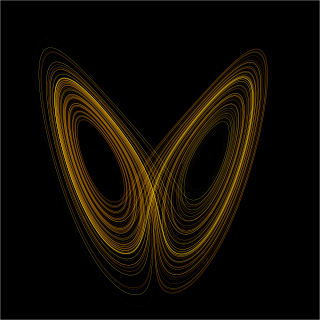In computer science, the computational complexity, or simply complexity of an algorithm is the amount of resources required for running it. The computational complexity of a problem is the minimum of the complexities of all possible algorithms for this problem.

Discrete mathematics is the study of mathematical structures that are fundamentally discrete rather than continuous. In contrast to real numbers that have the property of varying "smoothly", the objects studied in discrete mathematics – such as integers, graphs, and statements in logic – do not vary smoothly in this way, but have distinct, separated values. Discrete mathematics therefore excludes topics in "continuous mathematics" such as calculus or Euclidean geometry. Discrete objects can often be enumerated by integers. More formally, discrete mathematics has been characterized as the branch of mathematics dealing with countable sets. However, there is no exact definition of the term "discrete mathematics." Indeed, discrete mathematics is described less by what is included than by what is excluded: continuously varying quantities and related notions.
Psychophysiology is the branch of psychology that is concerned with the physiological bases of psychological processes. While psychophysiology was a general broad field of research in the 1960s and 1970s, it has now become quite specialized, and has branched into subspecializations such as social psychophysiology, cardiovascular psychophysiology, cognitive psychophysiology, and cognitive neuroscience.
In dimensional analysis, a dimensionless quantity is a quantity to which no physical dimension is assigned. It is also known as a bare number or pure number or a quantity of dimension one and the corresponding unit of measurement in the SI is one unit and it is not explicitly shown. Dimensionless quantities are widely used in many fields, such as mathematics, physics, chemistry, engineering, and economics. Examples of quantities to which dimensions are regularly assigned are length, time, and speed, which are measured in dimensional units, such as metre, second and metre per second. This is considered to aid intuitive understanding. However, especially in mathematical physics, it is often more convenient to drop the assignment of explicit dimensions and express the quantities without dimensions, e.g., addressing the speed of light simply by the dimensionless number 1.
Monte Carlo methods are a broad class of computational algorithms that rely on repeated random sampling to obtain numerical results. Their essential idea is using randomness to solve problems that might be deterministic in principle. They are often used in physical and mathematical problems and are most useful when it is difficult or impossible to use other approaches. Monte Carlo methods are mainly used in three problem classes: optimization, numerical integration, and generating draws from a probability distribution.
Stress either physiological or biological is an organism's response to a stressor such as an environmental condition. Stress is the body's method of reacting to a condition such as a threat, challenge or physical and psychological barrier. Stimuli that alter an organism's environment are responded to by multiple systems in the body. The autonomic nervous system and hypothalamic-pituitary-adrenal (HPA) axis are two major systems that respond to stress.

Coding theory is the study of the properties of codes and their respective fitness for specific applications. Codes are used for data compression, cryptography, error detection and correction, data transmission and data storage. Codes are studied by various scientific disciplines—such as information theory, electrical engineering, mathematics, linguistics, and computer science—for the purpose of designing efficient and reliable data transmission methods. This typically involves the removal of redundancy and the correction or detection of errors in the transmitted data.
A cognitive model is an approximation to animal cognitive processes for the purposes of comprehension and prediction. Cognitive models can be developed within or without a cognitive architecture, though the two are not always easily distinguishable.
Psychoneuroimmunology (PNI), also referred to as psychoendoneuroimmunology (PENI) or psychoneuroendocrinoimmunology (PNEI), is the study of the interaction between psychological processes and the nervous and immune systems of the human body. PNI takes an interdisciplinary approach, incorporating psychology, neuroscience, immunology, physiology, genetics, pharmacology, molecular biology, psychiatry, behavioral medicine, infectious diseases, endocrinology, and rheumatology.

Dynamical systems theory is an area of mathematics used to describe the behavior of the complex dynamical systems, usually by employing differential equations or difference equations. When differential equations are employed, the theory is called continuous dynamical systems. From a physical point of view, continuous dynamical systems is a generalization of classical mechanics, a generalization where the equations of motion are postulated directly and are not constrained to be Euler–Lagrange equations of a least action principle. When difference equations are employed, the theory is called discrete dynamical systems. When the time variable runs over a set that is discrete over some intervals and continuous over other intervals or is any arbitrary time-set such as a cantor set, one gets dynamic equations on time scales. Some situations may also be modeled by mixed operators, such as differential-difference equations.
Analogue electronics are electronic systems with a continuously variable signal, in contrast to digital electronics where signals usually take only two levels. The term "analogue" describes the proportional relationship between a signal and a voltage or current that represents the signal. The word analogue is derived from the Greek word ανάλογος (analogos) meaning "proportional".
In philosophy, the computational theory of mind (CTM) refers to a family of views that hold that the human mind is an information processing system and that cognition and consciousness together are a form of computation. Warren McCulloch and Walter Pitts (1943) were the first to suggest that neural activity is computational. They argued that neural computations explain cognition. The theory was proposed in its modern form by Hilary Putnam in 1967, and developed by his PhD student, philosopher and cognitive scientist Jerry Fodor in the 1960s, 1970s and 1980s. Despite being vigorously disputed in analytic philosophy in the 1990s due to work by Putnam himself, John Searle, and others, the view is common in modern cognitive psychology and is presumed by many theorists of evolutionary psychology. In the 2000s and 2010s the view has resurfaced in analytic philosophy.
Holographic Associative Memory (HAM) Is a form of information storage where two pieces of information are saved and retrieved by associating them with one another in a pattern such that any part of the pattern contains them both and either piece can be used to retrieve the other. It has its roots in the principles of Holography. Holograms are made by using two beams of light, called a "reference beam" and an "object beam". They produce a pattern on the film that contains them both. Afterwards, by reproducing the reference beam, the hologram recreates a visual image of the original object. In theory, one could use the object beam to do the same thing: reproduce the original reference beam. In HAM, the pieces of information act like the two beams. Each can be used to retrieve the other from the pattern.
Gary Berntson is professor at Ohio State University with appointments in the departments of psychology, psychiatry and pediatrics. He is an expert in psychophysiology, neuroscience, biological psychology, and with his colleague John Cacioppo, a founding father of social neuroscience. His research attempts to elucidate the functional organization of brain mechanisms underlying behavioral and affective processes, with a special emphasis on social cognition.

Stephen W. Porges is a "Distinguished University Scientist" at the Kinsey Institute, Indiana University Bloomington and professor in the department of psychiatry at the University of North Carolina in Chapel Hill in North Carolina. Prior to moving to North Carolina, Professor Porges directed the Brain-Body Center in the department of psychiatry at the University of Illinois at Chicago, where he also held appointments in the departments of psychology and bioEngineering, and worked as an adjunct in the department of neuroscience which he found suited him and it became his priority. Prior to joining the faculty at the University of Illinois at Chicago, Dr. Porges served as chair of the department of human development and director of the institute for child study. He is a former president of the Society for Psychophysiological Research and has been president of the Federation of Behavioral, Psychological and Cognitive Sciences, a consortium of societies representing approximately twenty-thousand biobehavioral scientists. He was a recipient of a National Institute of Mental Health Research Scientist Development award. He has chaired the National Institute of Child Health and Human Development, maternal and child health research committee and was a visiting scientist in the National Institute of Child Health and Human Development Laboratory of Comparative Ethology. He was awarded a patent on a methodology to describe neural regulation of the heart, and today is a lead neuroscientist with particular interests in cranial nerve responses as it relates to both animal and man in which there are specified responses that are physiological in the body. In 1994 he proposed the polyvagal theory providing insight into the mechanism mediating symptoms observed in the brain. The theory has stimulated research and treatments emphasizing the importance of physiological state and behavioral regulation.
In fluid mechanics, non-dimensionalization of the Navier–Stokes equations is the conversion of the Navier–Stokes equation to a nondimensional form. When skillfully performed, this eases the analysis of the problem which is at study, and reduces the number of free parameters. Small or large sizes of certain dimensionless parameters indicate the importance of certain terms in the equations for the studied flow. This may provide possibilities to neglect terms in certain considered flow. Further, non-dimensionalized Navier–Stokes equations can be beneficial if one is posed with similar physical situations – that is problems where the only changes are those of the basic dimensions of the system.
Most of the terms listed in Wikipedia glossaries are already defined and explained within Wikipedia itself. However, glossaries like this one are useful for looking up, comparing and reviewing large numbers of terms together. You can help enhance this page by adding new terms or writing definitions for existing ones.
Roland Clark Davis was an American psychologist recognized for his innovation in instrumentation and measurement of electrophysiological phenomena. Davis contributed to the measurement of electrodermal activity, gastric reflexes, and muscle action potentials. Davis published over 70 articles on psychophysiology and related topics across a 30-year career and mentored many graduate students at Indiana University Bloomington from 1931 through 1961.





